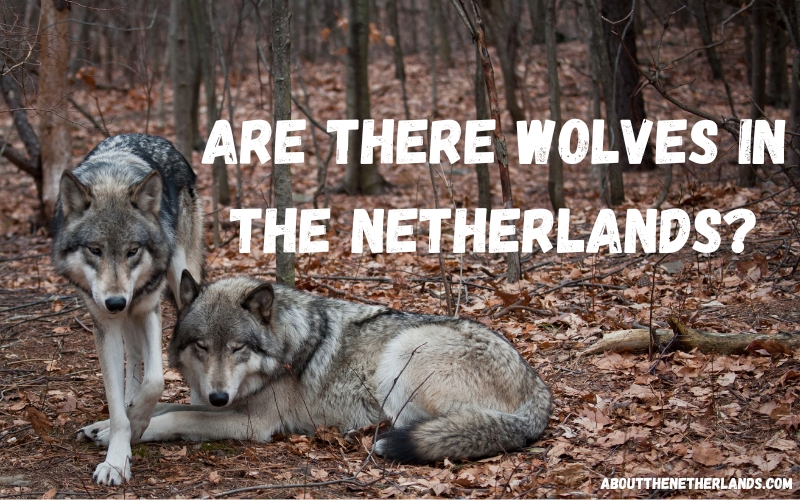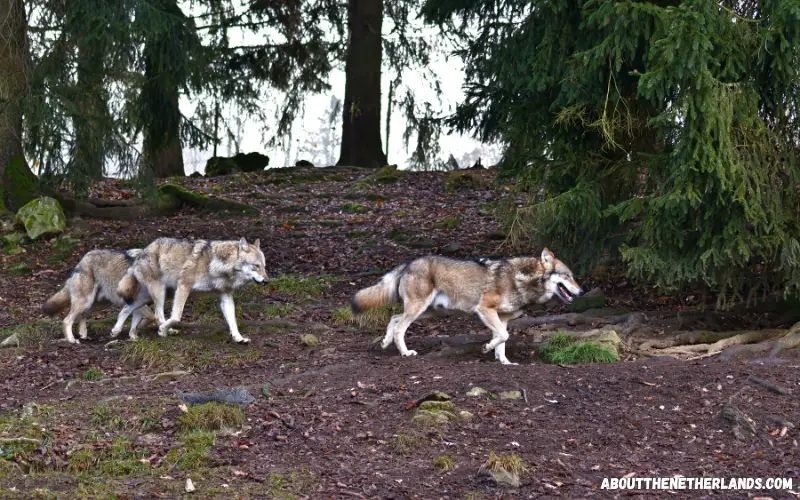

Wolves have long been absent from the Netherlands, but recent developments have led to the return of these magnificent creatures in the country. After a 140-year absence, the Netherlands welcomed its first resident wolf population, thanks to efforts from conservationists and an increased understanding of their significance in balancing ecosystems.
According to BBC News, the reintroduction of wolves was made possible by natural migration and repopulation, as many European countries are experiencing an increase in their wolf populations.
Interestingly, a World Wildlife Fund report revealed that 54% of the Dutch population believes that wolves deserve a place in the Netherlands, and 76% do not see them as a threat to humans. However, concerns remain regarding the possible challenges that the growing wolf population might bring with it.
In the past, wolves were a common sight in the Netherlands. However, due to hunting and habitat loss, their population significantly declined in the country. By the end of the 19th century, wolves were considered extinct in the Netherlands, with no resident populations observed for over a century.
Over recent decades, wolves have been making a comeback in various parts of Europe. The presence of wolves in the Netherlands again became evident in 2015 when a male wolf from Germany was spotted in the country, searching for new territory.
Since then, the presence of wolves in the Netherlands has been a heavily discussed topic as the population continues to expand.
By 2019, ongoing research confirmed the existence of a settled wolf population in the Netherlands, marking the first time in 140 years that the country had resident wolves. This development has been met with both hope and concern from the Dutch public, as opinions on the presence of wolves in the country vary significantly.
Nonetheless, the return of wolves in the Netherlands points to a broader trend of wildlife recovery in Europe.
In recent years, wolves have been making a comeback in Europe, and this includes the Netherlands. Thanks to conservation and recolonization efforts, their population has been expanding, and the debate surrounding their presence has heated up.
As per the Dutch Ministry of Agriculture, Nature, and Food Quality, 54% of the Dutch population believes that wolves deserve a place in the Netherlands, while 76% do not see them as a threat to humans.
For the first time in 140 years, the Netherlands has a resident wolf population. In 2019, ecologists reported that the Hoge Veluwe nature reserve became home to two female wolves and a roaming male (International Wolf Center).
More recently, a report from June 2022 indicated that the Netherlands is believed to be home to at least 20 adult wolves, including a pack and two pairs in the Veluwe, and another pair on the border between Drenthe and Friesland(The Guardian).
The return of wolves has led to various management strategies, such as using paintballs to scare off wolves that become too tame in areas like Hoge Veluwe National Park.
In conclusion, the recolonization of wolves in the Netherlands has been successful in recent years, with confirmed sightings and an increasing population. Efforts to manage their presence and coexist with human populations are ongoing.

Wolves have made a return to the Netherlands, with the first resident wolf population in over 140 years being reported. These wolves have been present in the country almost continuously since 2017, with the first individual wolves settling in the Veluwe region in the summer of 2018.
The Veluwe region has become a significant area for wolf activity, with the first wolves settling there in 2018. The region offers a suitable habitat for the wolf population, providing ample food sources and natural cover for the wolves to thrive.
Since their return, wolves have also been sighted in other regions of the Netherlands, indicating that they have been roaming in search of new habitats and potential partners. This highlights the likelihood of an expanding wolf population within the country.
Conservation efforts in the Netherlands have played a vital role in facilitating the return of wolves to the country.
Research conducted by the Dutch Ministry of Agriculture, Nature, and Food Quality reveals that 54% of the Dutch population believes that the wolf should be allowed to reside in the Netherlands, while 76% do not consider the wolf to pose a danger to humans.
As the wolf population continues to grow, it is essential to preserve and protect the natural habitats that allow these animals to thrive. Efforts to maintain biodiversity and promote sustainable land-use practices will be crucial in ensuring that wolves remain a part of the Dutch ecosystem.
Wolves have returned to the Netherlands after approximately 140 years of absence, and their presence has significant ecological implications.
As apex predators, wolves play a crucial role in regulating the populations of their prey species, such as deer and wild boar. By controlling the numbers of these herbivores, wolves help maintain a balance within the ecosystem, which can have positive ripple effects throughout the environment.
For instance, a reduced herbivore population can reduce overgrazing and thus promote the growth and diversity of plant species.
Wolves indirectly influence vegetation through their impact on prey populations. When herbivore numbers are regulated by wolves, plants can grow more abundantly and diversify. This, in turn, supports a larger number of species within the ecosystem, promoting overall biodiversity.
However, it is important to note that the extent to which wolves will have an impact on vegetation in the Netherlands is still uncertain. The magnitude of ecosystem effects by wolves largely depends on factors such as the population sizes of wolves and their prey, the area size, and human activities (ScienceDirect).
As wolves return to the Netherlands, their presence has generated various opinions and concerns among the Dutch population.
Research by the country's Ministry of Agriculture, Nature, and Food Quality revealed that 54% of Dutch citizens believe that wolves deserve a place in the Netherlands, and 76% do not see them as a threat to humans.
However, there are still valid concerns, particularly with the impact on livestock and the potential for human-wolf conflicts.
One of the primary concerns associated with the presence of wolves is the potential harm they could cause to livestock.
Several measures can be employed to minimize this risk, such as installing electric fencing, employing livestock guardian dogs, and implementing preventive measures to keep wolves away from farmlands (Springer).
Moreover, some countries with established wolf populations have developed compensation programs. These initiatives aim to enhance the tolerance of wolves among livestock owners by providing financial support for depredations, thereby reducing the retaliatory killing of wolves.
Engaging the community in discussions about wolf conservation and coexistence is essential for developing a harmonious relationship between humans and wolves.
Periodic communication efforts, educational programs, and awareness campaigns can help bridge the knowledge gap and foster a positive attitude towards these iconic apex predators returning to the Netherlands.
By involving different stakeholders, including farmers, wildlife organizations, and local communities, enduring solutions can be identified and implemented to minimize conflicts and promote a balanced coexistence of human and wild inhabitants in the region (ResearchGate).
Wolves have returned to the Netherlands after 140 years, with their population numbers continuing to grow. These animals are now protected under national and international legislation, along with conservation and management plans to ensure their continued presence in the Dutch ecosystem.
The Dutch government has implemented the Nature Conservation Act, taking effect from 1 January 2017, which aims to protect nature areas, wild animals, and plants in the country.
This new act replaces three previous laws – the Nature Conservancy Act 1998, the Flora and Fauna Act, and the Forestry Act – to provide comprehensive protection for wildlife, including wolves.
Furthermore, the French Government has designed a wolf cohabitation plan, targeting a population of 500 wolves by 2023. This target is believed to be achieved or even surpassed by the set date.
Efforts to conserve wolves in Europe go beyond national borders. Countries, including the Netherlands, are working together to ensure the protection and conservation of these animals.
A key example of this cooperation is the Pan European Ecological Network, which aims to increase connectivity among European habitats, promoting the exchange of wolf populations between different regions.
Some concerns have been expressed about the growing wolf population in the Netherlands, with a Dutch MEP supporting an EU effort to reduce protection for wolves.
However, statistics show that wolves were only accountable for 0.2% of the damage to fauna in the Netherlands in 2020, with just nine recorded instances of wolves attacking livestock between February and May that year.
With international cooperation and sound conservation legislation in place, wolf populations are gradually returning to their historical ranges in Europe.
The most densely-populated countries, like the Netherlands, are also witnessing a resurgence of wolves, demonstrating the continent's ability to accommodate these elusive predators.
After decades of absence, wolves have indeed returned to the Netherlands. Ecologists have confirmed the presence of the country's first resident wolf population in 140 years, marking an important moment for wildlife conservation in the region.
Public opinion on the return of wolves to the Netherlands is generally positive. A majority of Dutch citizens view wolves as deserving of a place in their country, and many do not perceive them as a threat to humans.
However, concerns have been raised by some farmers as wolves have been responsible for the death of more than 160 sheep in recent years (Utrecht University).
Organizations such as Wolven in Nederland promote conflict-free reintroduction and coexistence between wolves and humans. As the wolves' territory in the Netherlands depends on the availability of food, proactive approaches and awareness are essential in learning to live together with this returning predator.
Want to learn more about nature and animals in the Netherlands, for example, whether there are snakes in the Netherlands? Then check out these two articles!